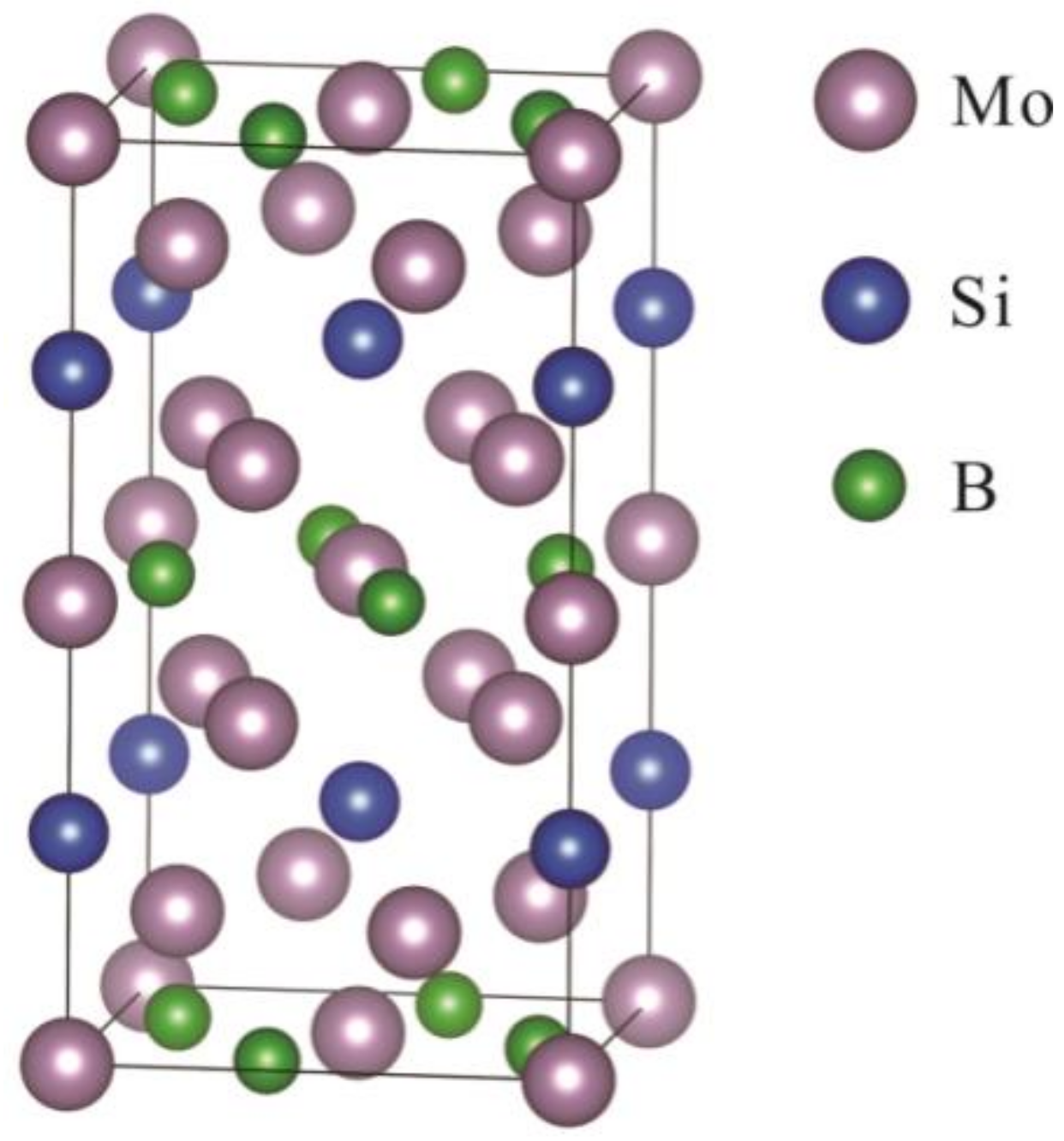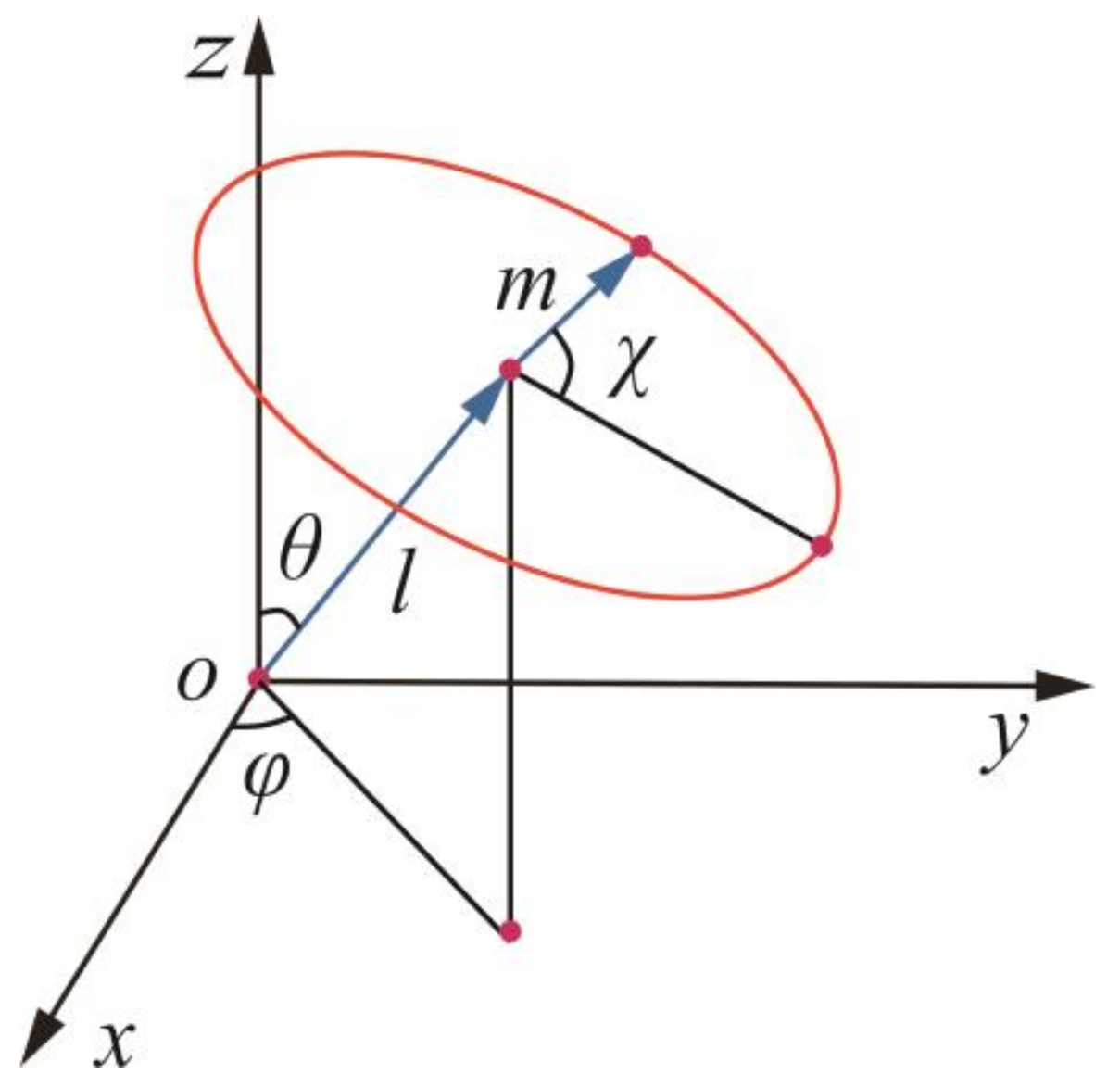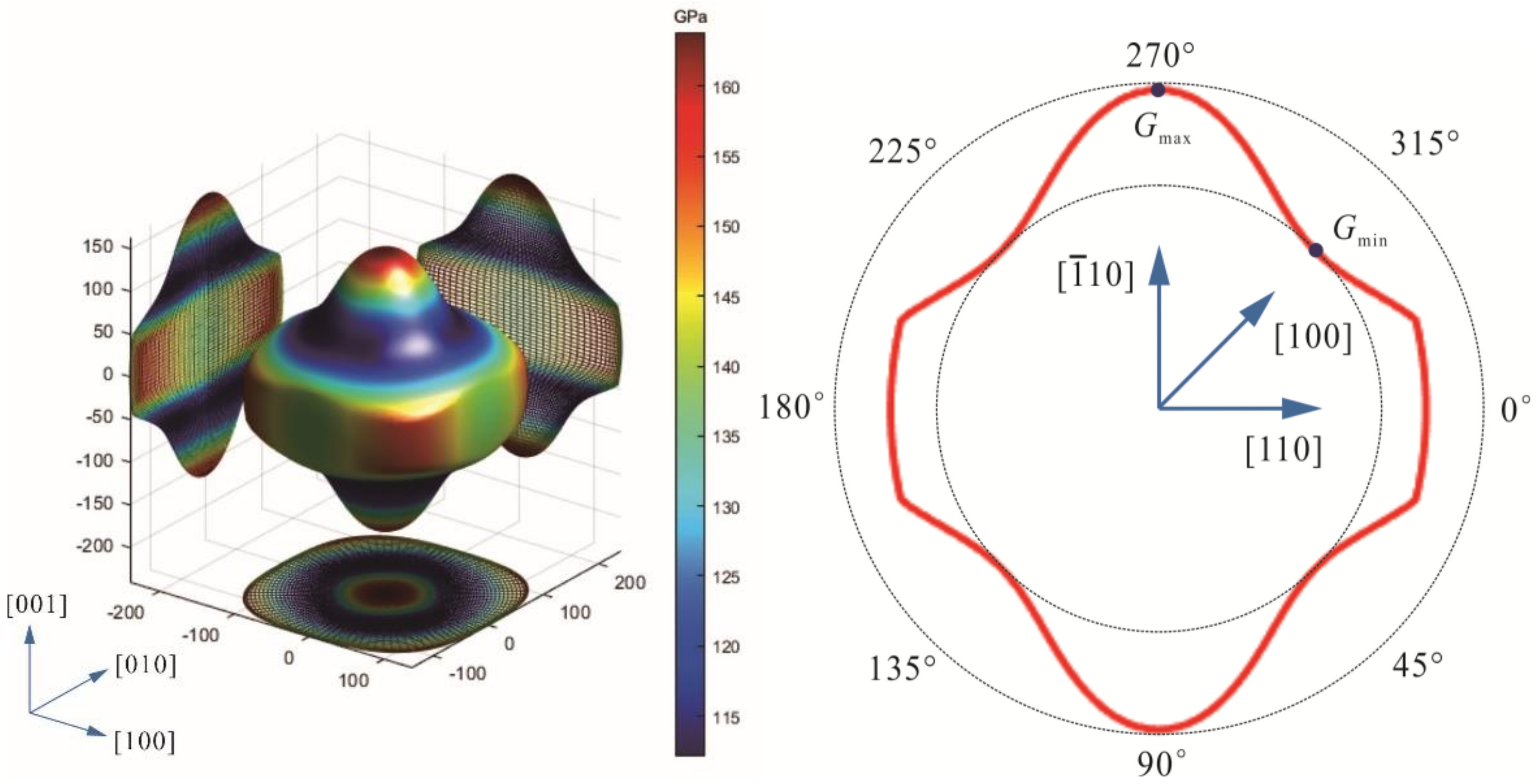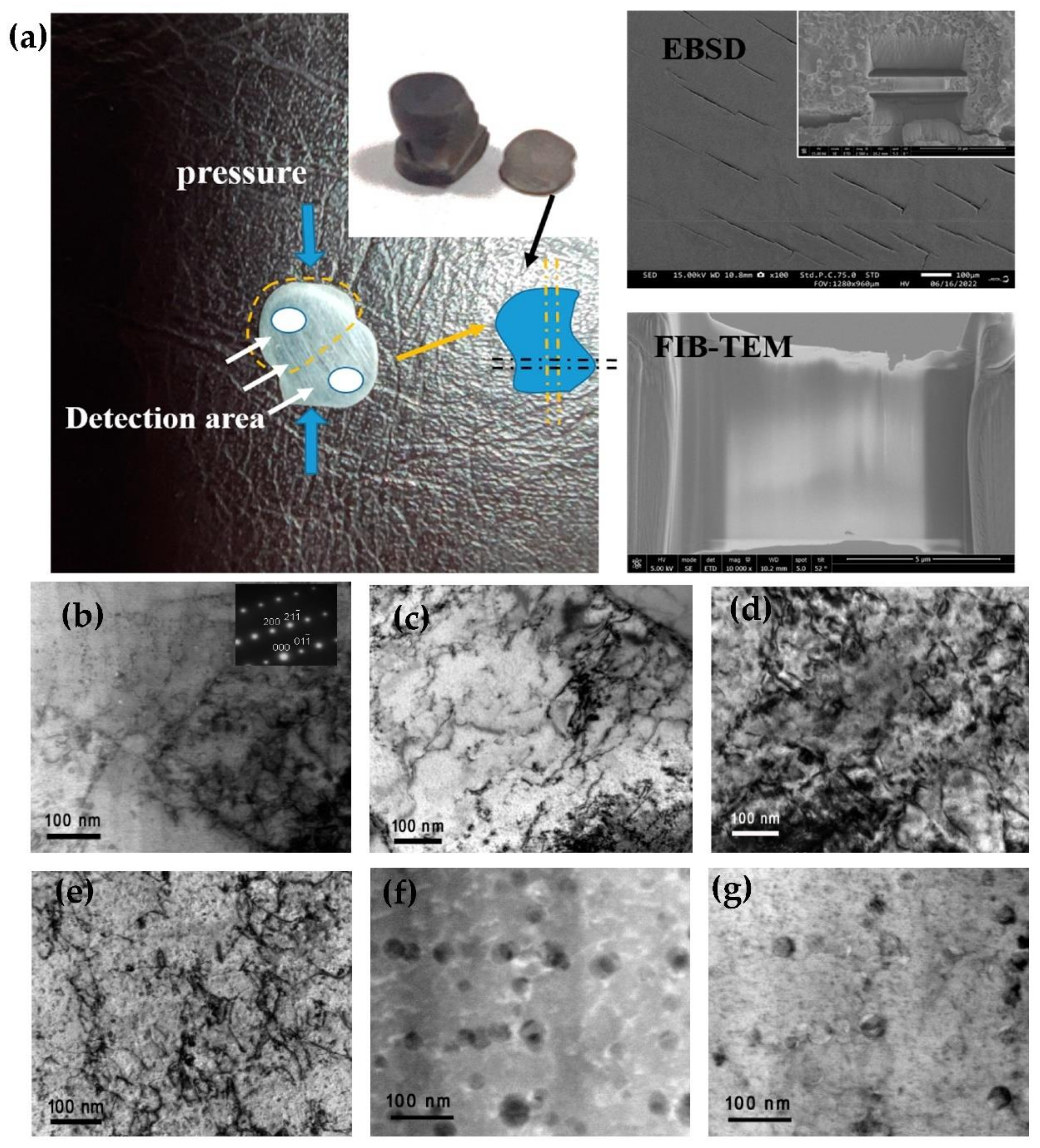Elastic Moduli and Mechanical Properties of Mo5SiB2 Single Crystals in the Mo-Si-B System
Abstract
:1. Introduction
2. Experiment Procedures
3. Results and Discussion
3.1. Elastic Modulus and Shear Modulus Simulation
3.2. Mechanical Properties of Mo5SiB2 Single Crystals
4. Conclusions
Author Contributions
Funding
Conflicts of Interest
References
- Jain, P.; Alur, A.P.; Kumar, K.S. High temperature compressive flow behavior of a Mo–Si–B solid solution alloy. Scr. Mater. 2006, 54, 13–17. [Google Scholar] [CrossRef]
- Alur, A.P.; Chollacoop, N.; Kumar, K.S. Creep effects on crack growth in a Mo-Si-B alloy. Acta Mater. 2004, 52, 5571–5587. [Google Scholar] [CrossRef]
- Schmelzer, J.; Rittinghaus, S.K.; Weisheit, A.; Stobik, M.; Paulus, J.; Gruber, K.; Wessel, E.; Heinze, C.; Krüger, M. Printability of gas atomized Mo-Si-B powders by laser metal deposition. Int. J. Refract. Met. Hard Mater. 2019, 78, 123–126. [Google Scholar] [CrossRef]
- Kishida, K.; Maruyama, T.; Matsunoshita, H.; Fukuyama, T.; Inui, H. Micropillar compression deformation of single crystals of Mo5SiB2 with the tetragonal D8l structure. Acta Mater. 2018, 159, 416–428. [Google Scholar] [CrossRef]
- Makineni, S.K.; Kini, A.R.; Jagle, E.A.; Springer, H.; Raabe, D.; Gault, B. Synthesis and stabilization of a new phase regime in a Mo-Si-B based alloy by laser-based additive manufacturing. Acta Mater. 2018, 151, 31–40. [Google Scholar] [CrossRef]
- Pan, K.; Yang, Y.; Wei, S.; Wu, H.; Dong, Z.; Wu, Y.; Wang, S.; Zhang, L.; Lin, J.; Mao, X. Oxidation be havior of Mo-Si-B alloys at medium-to-high temperatures. J. Mater. Sci. Technol. 2021, 60, 113–127. [Google Scholar] [CrossRef]
- Cheng, Z.; Wang, S.; Wu, G.; Gao, J.; Yang, X.; Wu, H. Tribological properties of high-entropy alloys: Areview. Int. J. Miner. Metall. Mater. 2022, 29, 389–403. [Google Scholar] [CrossRef]
- Wang, Z.; Wu, H.; Wu, Y.; Huang, H.; Zhu, X.; Zhang, Y.; Zhu, H.; Yuan, X.; Chen, Q.; Wang, S.; et al. Solving oxygen embrittlement of refractory high-entropy alloy via grain boundary engineering. Mater. Today 2022, 54, 83–89. [Google Scholar] [CrossRef]
- Hayashi, T.; Ito, K.; Ihara, K.; Fujikura, M.; Yamaguchi, M. Creep of single crystalline and polycrystalline T2 phase in the Mo–Si–B system. Intermetallics 2004, 12, 699–704. [Google Scholar] [CrossRef]
- Schneibel, J. High temperature strength of Mo–Mo3Si–Mo5SiB2 molybdenum silicides. Intermetallics 2003, 11, 625–632. [Google Scholar] [CrossRef]
- Kruzic, J.J.; Schneibel, J.H.; Ritchie, R.O. Ambient-to elevated-temperature fracture and fatigue properties of Mo-Si-B alloys: Role of microstructure. Metall. Mater. Trans. A 2005, 36, 2393–2402. [Google Scholar] [CrossRef]
- Floquet, N.; Bertrand, O.; Heizmann, J.J. Structural and morphological studies of the growth of MoO3 scales during high-temperature oxidation of molybdenum. Oxid. Met. 1992, 37, 253–280. [Google Scholar] [CrossRef]
- Deng, X.; Zhang, G.; Wang, T.; Ren, S.; Shi, Y.; Bai, Z.; Cao, Q. Microstructure and oxidation resistance of a multiphase Mo-Si-B ceramic coating on Mo substrates deposited by a plasma transferred arc process. Ceram. Int. 2019, 45, 415–423. [Google Scholar] [CrossRef]
- Meyer, M.K.; Akinc, M. Oxidation Behavior of Boron-Modified Mo5Si3 at 800 °C–1300 °C. J. Am. Ceram. Soc. 1996, 79, 938–944. [Google Scholar] [CrossRef]
- Meyer, M.K.; Kramer, M.J.; Akinca, M. Compressive creep behavior of Mo5Si3 with the addition of boron. Intermetallics 1996, 4, 273–281. [Google Scholar] [CrossRef]
- Ito, K.; Ihara, K.; Tanaka, K.; Fujikura, M.; Yamaguchi, M. Physical and mechanical properties of single crystals of the T2 phase in the Mo-Si-B system. Intermetallics 2001, 9, 591–602. [Google Scholar] [CrossRef]
- Ito, K.; Ihara, K.; Fujikura, M.; Yamaguchi, M.; Hemker, K.J.; Dimiduk, D.M.; Clemens, H.; Darolia, R.; Inui, H.; Larsen, J.M.; et al. (Eds.) Structural Intermetallics; TMS: Warrendale, PA, USA, 2001; pp. 441–446. [Google Scholar]
- Zhang, L.Q.; Pan, K.M.; Du, W.; Wang, M.; Lin, J.; Ni, X.; Shang, H.; Sun, J. Intrinsic brittleness of Mo5SiB2 and alloying effecton ductility studied by first-principles calculations. Intermetallics 2014, 50, 79–85. [Google Scholar] [CrossRef]
- Zhang, L.Q.; Pan, K.M.; Lin, J.P. Fracture toughness and fracture mechanisms in Mo5SiB2 at ambient to elevated temperatures. Intermetallics 2013, 38, 49–54. [Google Scholar] [CrossRef]
- Field, R. Dislocations in Mo5SiB2 T2 phase. Intermetallics 2001, 9, 863–868. [Google Scholar] [CrossRef] [Green Version]
- Zhao, H.L.; Kramer, M.J.; Akinc, M. Thermal expansion behavior of intermetallic compounds in the Mo-Si-B system. Intermetallics 2004, 12, 493–498. [Google Scholar] [CrossRef]
- Sekido, N.; Sakidja, R.; Perepezko, J. Annealing response of point defects in off-stoichiometric Mo5SiB2 phase. Intermetallics 2007, 15, 1268–1276. [Google Scholar] [CrossRef]
- Sakidja, R.; Perepezko, J.H. Phase stability and alloying behavior in the Mo-Si-B system. Metall. Mater. Trans. A 2005, 36, 507–514. [Google Scholar] [CrossRef]
- Sakidja, R.; Perepezko, J.H.; Kim, S.; Sekido, N. Phase stability and structural defects in high-temperature Mo-Si-B alloys. Acta Mater. 2008, 56, 5223–5244. [Google Scholar] [CrossRef]
- Yang, Y.; Chang, C.Y. Thermo dynamic modeling of the Mo-Si-B system. Intermetallics 2005, 13, 121–128. [Google Scholar] [CrossRef]
- Wang, F.; Shan, A.; Dong, X.; Wu, J.S. Oxidation behavior of multiphase Mo5SiB2 (T2)-based alloys at high temperatures. Trans. Nonferrous Met. Soc. China 2007, 17, 1242–1247. [Google Scholar] [CrossRef]
- Jiang, W.H.; Yao, X.D.; Guan, H.R.; Hu, Z.Q. Carbide behavior during high temperature creep in DZ40M Co-base superalloy. Mater. Sci. Technol. 1999, 15, 515–518. [Google Scholar]
- Pan, K.M.; Zhang, L.Q.; Wei, S.Z.; Zhao, Y. Dislocation climb in Mo5SiB2 during high-temperature deformation. Int. J. Refract. Met. Hard Mater. 2016, 61, 115–120. [Google Scholar] [CrossRef]
- Pan, K.M.; Liu, W.; Zhang, L.Q.; Wei, S.; You, L.; Lin, J.; Li, J.; Xu, L.; Zhou, S.; Han, M. Deformation behavior of Mo5SiB2 at elevated temperatures. Mater. Sci. Eng. A 2015, 623, 124–132. [Google Scholar] [CrossRef]
- Knowles, K.M.; Howie, P.R. The directional dependence of elastic stiffness and compliance shear coefficients and shear moduli in cubic materials. J. Elast. 2014, 120, 87–108. [Google Scholar] [CrossRef]








Publisher’s Note: MDPI stays neutral with regard to jurisdictional claims in published maps and institutional affiliations. |
© 2022 by the authors. Licensee MDPI, Basel, Switzerland. This article is an open access article distributed under the terms and conditions of the Creative Commons Attribution (CC BY) license (https://creativecommons.org/licenses/by/4.0/).
Share and Cite
Pan, K.; Zhang, C.; Dong, G.; Wang, R.; Yu, H.; Wang, C.; Ren, Y. Elastic Moduli and Mechanical Properties of Mo5SiB2 Single Crystals in the Mo-Si-B System. Crystals 2022, 12, 1577. https://doi.org/10.3390/cryst12111577
Pan K, Zhang C, Dong G, Wang R, Yu H, Wang C, Ren Y. Elastic Moduli and Mechanical Properties of Mo5SiB2 Single Crystals in the Mo-Si-B System. Crystals. 2022; 12(11):1577. https://doi.org/10.3390/cryst12111577
Chicago/Turabian StylePan, Kunming, Chengyang Zhang, Gaogao Dong, Rui Wang, Hua Yu, Changji Wang, and Yongpeng Ren. 2022. "Elastic Moduli and Mechanical Properties of Mo5SiB2 Single Crystals in the Mo-Si-B System" Crystals 12, no. 11: 1577. https://doi.org/10.3390/cryst12111577



